Comparison of Microscopy Techniques
VerifiedAdded on 2023/04/12
|16
|3493
|249
AI Summary
This report discusses the different types of microscopy techniques, including optical microscopy and electron microscopy, and their significance in biomedical research and manufacturing. It explores the uses, advantages, and limitations of each technique and their application in implantation and analysis of medical devices. The report aims to evaluate the usage, advantages, and limitations of optical and electron microscopy techniques applied to implanted medical devices.
Contribute Materials
Your contribution can guide someone’s learning journey. Share your
documents today.
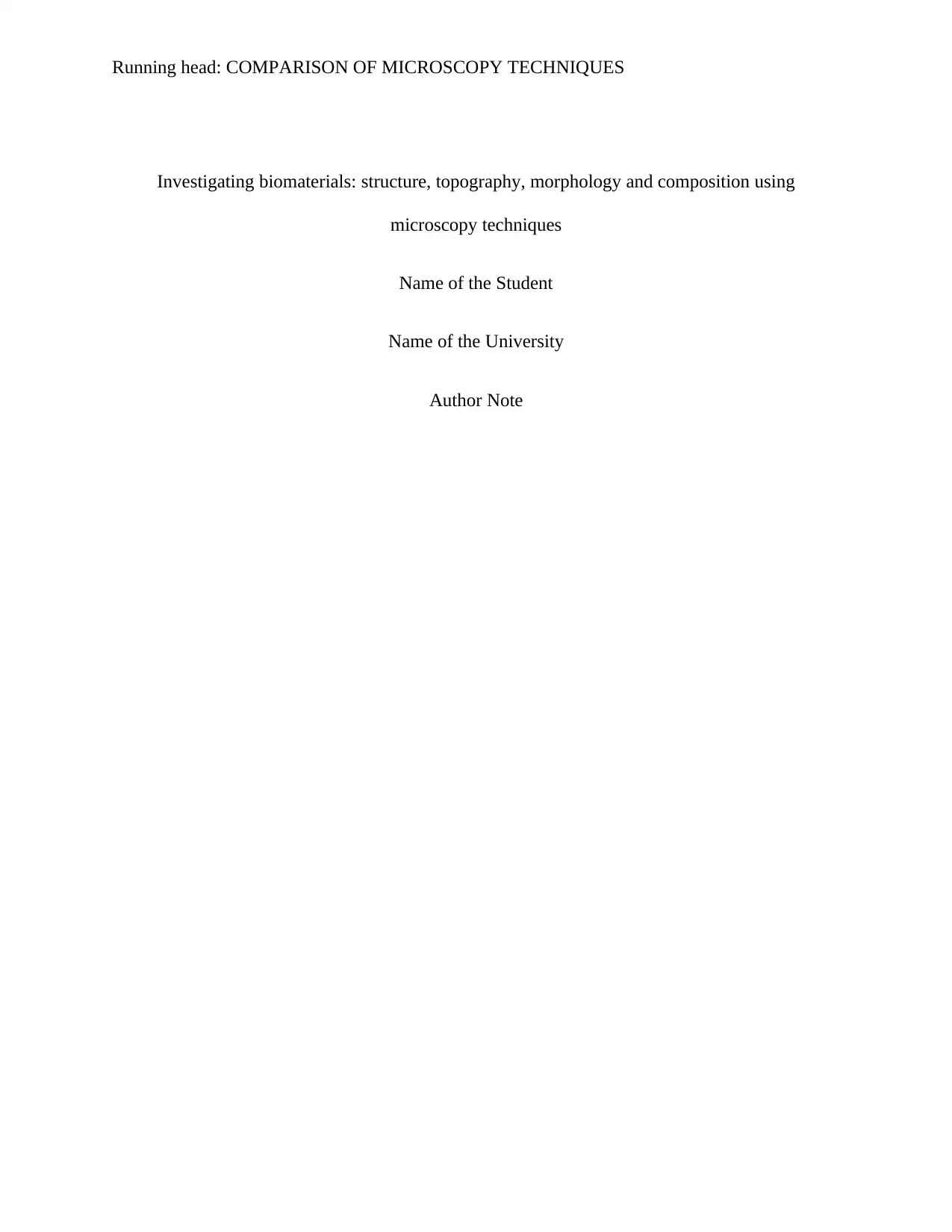
Running head: COMPARISON OF MICROSCOPY TECHNIQUES
Investigating biomaterials: structure, topography, morphology and composition using
microscopy techniques
Name of the Student
Name of the University
Author Note
Investigating biomaterials: structure, topography, morphology and composition using
microscopy techniques
Name of the Student
Name of the University
Author Note
Secure Best Marks with AI Grader
Need help grading? Try our AI Grader for instant feedback on your assignments.
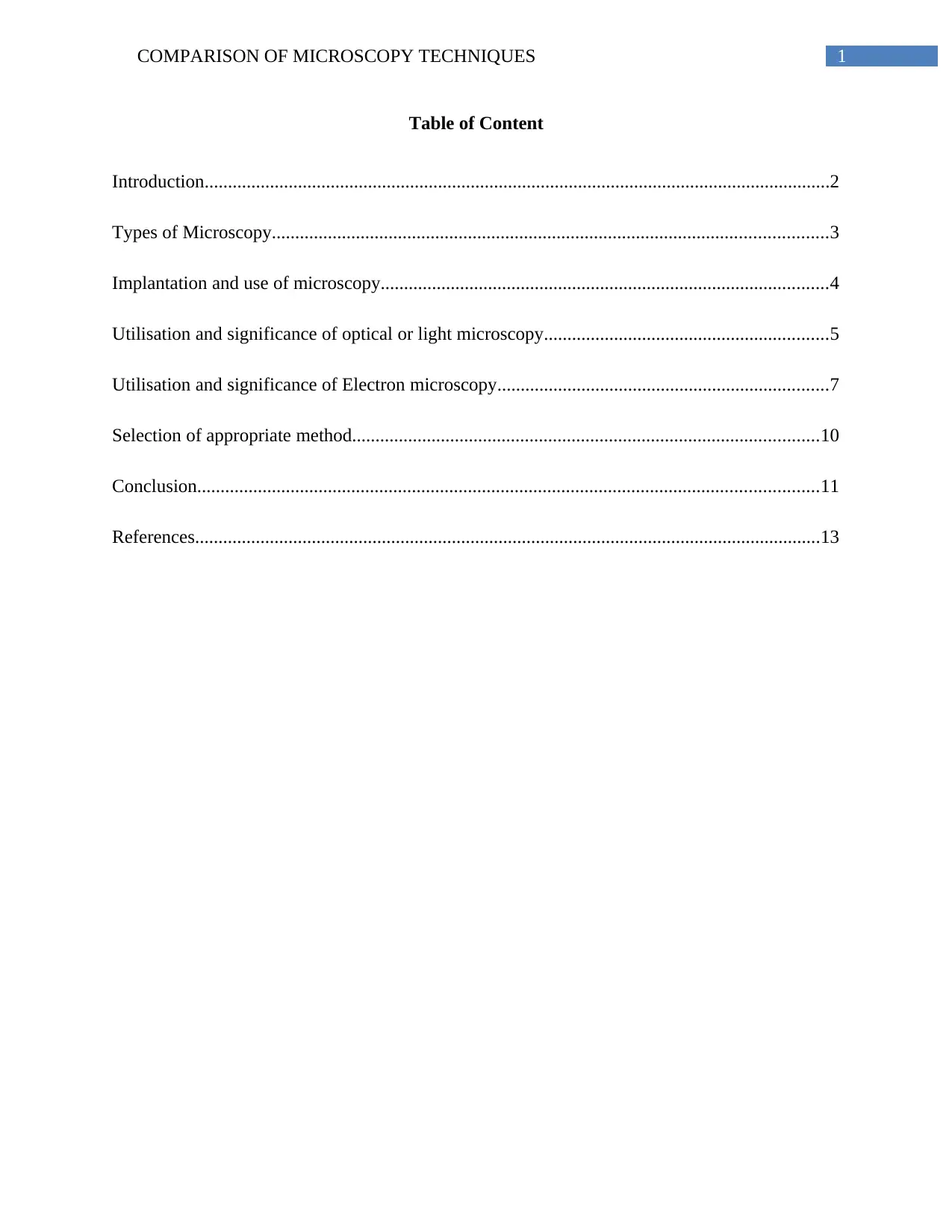
1COMPARISON OF MICROSCOPY TECHNIQUES
Table of Content
Introduction......................................................................................................................................2
Types of Microscopy.......................................................................................................................3
Implantation and use of microscopy................................................................................................4
Utilisation and significance of optical or light microscopy.............................................................5
Utilisation and significance of Electron microscopy.......................................................................7
Selection of appropriate method....................................................................................................10
Conclusion.....................................................................................................................................11
References......................................................................................................................................13
Table of Content
Introduction......................................................................................................................................2
Types of Microscopy.......................................................................................................................3
Implantation and use of microscopy................................................................................................4
Utilisation and significance of optical or light microscopy.............................................................5
Utilisation and significance of Electron microscopy.......................................................................7
Selection of appropriate method....................................................................................................10
Conclusion.....................................................................................................................................11
References......................................................................................................................................13
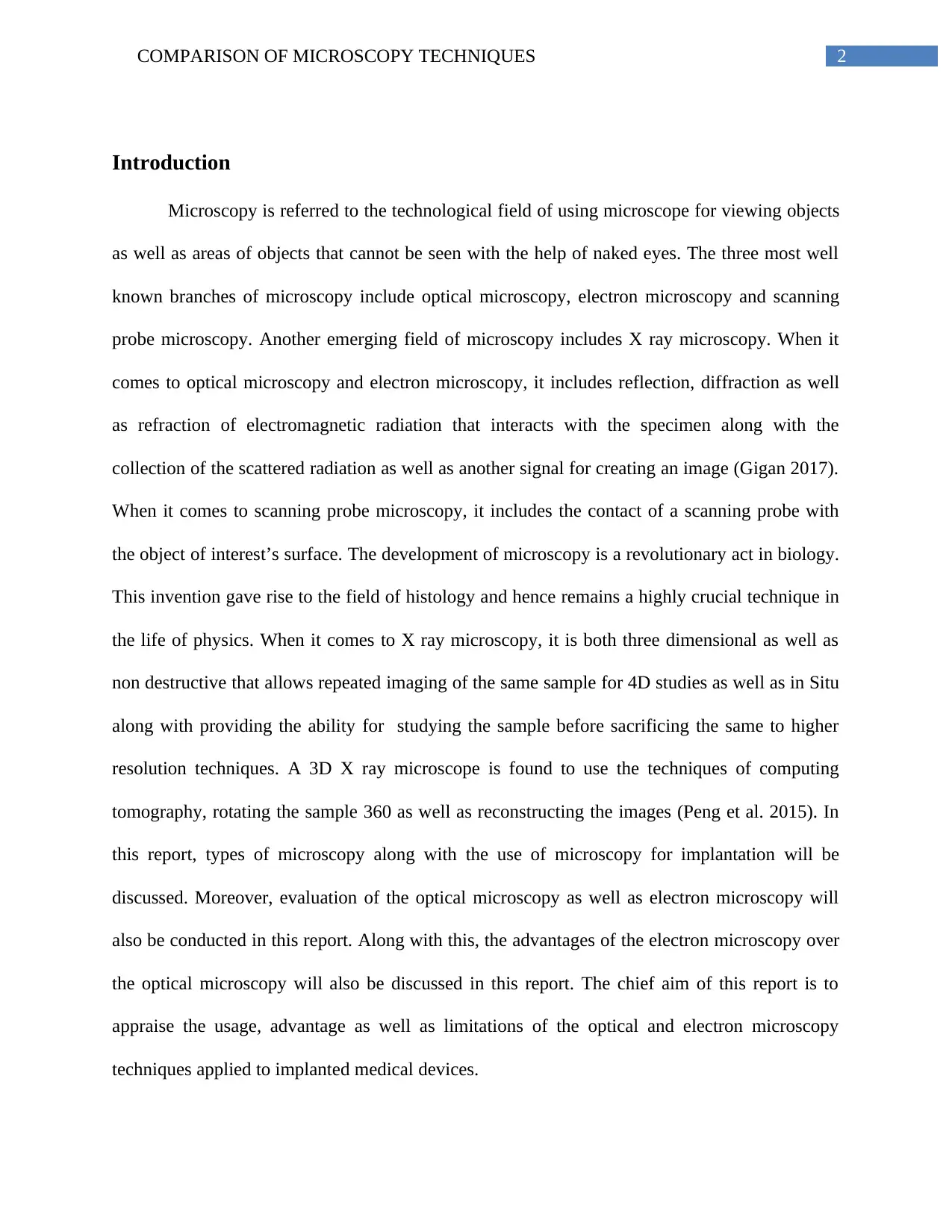
2COMPARISON OF MICROSCOPY TECHNIQUES
Introduction
Microscopy is referred to the technological field of using microscope for viewing objects
as well as areas of objects that cannot be seen with the help of naked eyes. The three most well
known branches of microscopy include optical microscopy, electron microscopy and scanning
probe microscopy. Another emerging field of microscopy includes X ray microscopy. When it
comes to optical microscopy and electron microscopy, it includes reflection, diffraction as well
as refraction of electromagnetic radiation that interacts with the specimen along with the
collection of the scattered radiation as well as another signal for creating an image (Gigan 2017).
When it comes to scanning probe microscopy, it includes the contact of a scanning probe with
the object of interest’s surface. The development of microscopy is a revolutionary act in biology.
This invention gave rise to the field of histology and hence remains a highly crucial technique in
the life of physics. When it comes to X ray microscopy, it is both three dimensional as well as
non destructive that allows repeated imaging of the same sample for 4D studies as well as in Situ
along with providing the ability for studying the sample before sacrificing the same to higher
resolution techniques. A 3D X ray microscope is found to use the techniques of computing
tomography, rotating the sample 360 as well as reconstructing the images (Peng et al. 2015). In
this report, types of microscopy along with the use of microscopy for implantation will be
discussed. Moreover, evaluation of the optical microscopy as well as electron microscopy will
also be conducted in this report. Along with this, the advantages of the electron microscopy over
the optical microscopy will also be discussed in this report. The chief aim of this report is to
appraise the usage, advantage as well as limitations of the optical and electron microscopy
techniques applied to implanted medical devices.
Introduction
Microscopy is referred to the technological field of using microscope for viewing objects
as well as areas of objects that cannot be seen with the help of naked eyes. The three most well
known branches of microscopy include optical microscopy, electron microscopy and scanning
probe microscopy. Another emerging field of microscopy includes X ray microscopy. When it
comes to optical microscopy and electron microscopy, it includes reflection, diffraction as well
as refraction of electromagnetic radiation that interacts with the specimen along with the
collection of the scattered radiation as well as another signal for creating an image (Gigan 2017).
When it comes to scanning probe microscopy, it includes the contact of a scanning probe with
the object of interest’s surface. The development of microscopy is a revolutionary act in biology.
This invention gave rise to the field of histology and hence remains a highly crucial technique in
the life of physics. When it comes to X ray microscopy, it is both three dimensional as well as
non destructive that allows repeated imaging of the same sample for 4D studies as well as in Situ
along with providing the ability for studying the sample before sacrificing the same to higher
resolution techniques. A 3D X ray microscope is found to use the techniques of computing
tomography, rotating the sample 360 as well as reconstructing the images (Peng et al. 2015). In
this report, types of microscopy along with the use of microscopy for implantation will be
discussed. Moreover, evaluation of the optical microscopy as well as electron microscopy will
also be conducted in this report. Along with this, the advantages of the electron microscopy over
the optical microscopy will also be discussed in this report. The chief aim of this report is to
appraise the usage, advantage as well as limitations of the optical and electron microscopy
techniques applied to implanted medical devices.
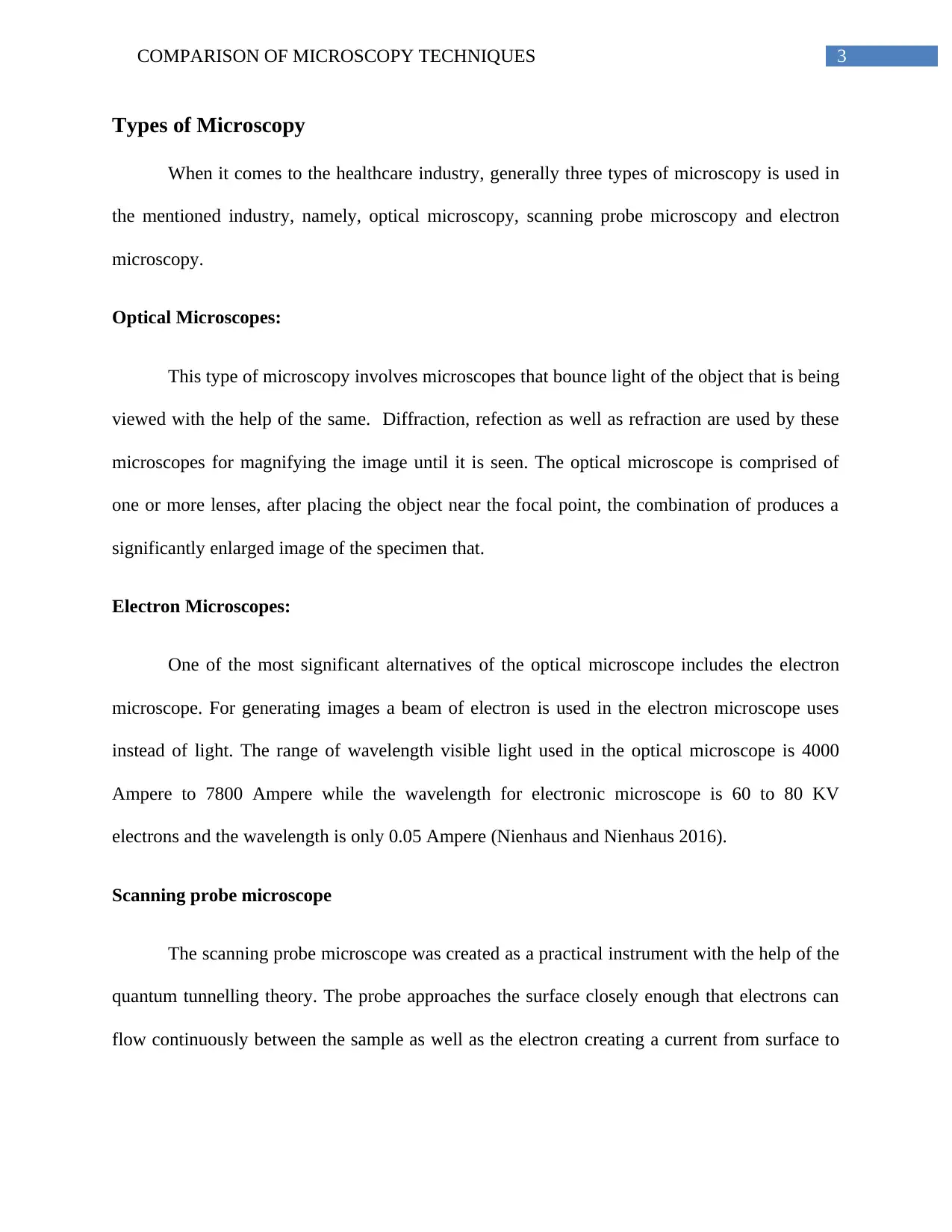
3COMPARISON OF MICROSCOPY TECHNIQUES
Types of Microscopy
When it comes to the healthcare industry, generally three types of microscopy is used in
the mentioned industry, namely, optical microscopy, scanning probe microscopy and electron
microscopy.
Optical Microscopes:
This type of microscopy involves microscopes that bounce light of the object that is being
viewed with the help of the same. Diffraction, refection as well as refraction are used by these
microscopes for magnifying the image until it is seen. The optical microscope is comprised of
one or more lenses, after placing the object near the focal point, the combination of produces a
significantly enlarged image of the specimen that.
Electron Microscopes:
One of the most significant alternatives of the optical microscope includes the electron
microscope. For generating images a beam of electron is used in the electron microscope uses
instead of light. The range of wavelength visible light used in the optical microscope is 4000
Ampere to 7800 Ampere while the wavelength for electronic microscope is 60 to 80 KV
electrons and the wavelength is only 0.05 Ampere (Nienhaus and Nienhaus 2016).
Scanning probe microscope
The scanning probe microscope was created as a practical instrument with the help of the
quantum tunnelling theory. The probe approaches the surface closely enough that electrons can
flow continuously between the sample as well as the electron creating a current from surface to
Types of Microscopy
When it comes to the healthcare industry, generally three types of microscopy is used in
the mentioned industry, namely, optical microscopy, scanning probe microscopy and electron
microscopy.
Optical Microscopes:
This type of microscopy involves microscopes that bounce light of the object that is being
viewed with the help of the same. Diffraction, refection as well as refraction are used by these
microscopes for magnifying the image until it is seen. The optical microscope is comprised of
one or more lenses, after placing the object near the focal point, the combination of produces a
significantly enlarged image of the specimen that.
Electron Microscopes:
One of the most significant alternatives of the optical microscope includes the electron
microscope. For generating images a beam of electron is used in the electron microscope uses
instead of light. The range of wavelength visible light used in the optical microscope is 4000
Ampere to 7800 Ampere while the wavelength for electronic microscope is 60 to 80 KV
electrons and the wavelength is only 0.05 Ampere (Nienhaus and Nienhaus 2016).
Scanning probe microscope
The scanning probe microscope was created as a practical instrument with the help of the
quantum tunnelling theory. The probe approaches the surface closely enough that electrons can
flow continuously between the sample as well as the electron creating a current from surface to
Secure Best Marks with AI Grader
Need help grading? Try our AI Grader for instant feedback on your assignments.
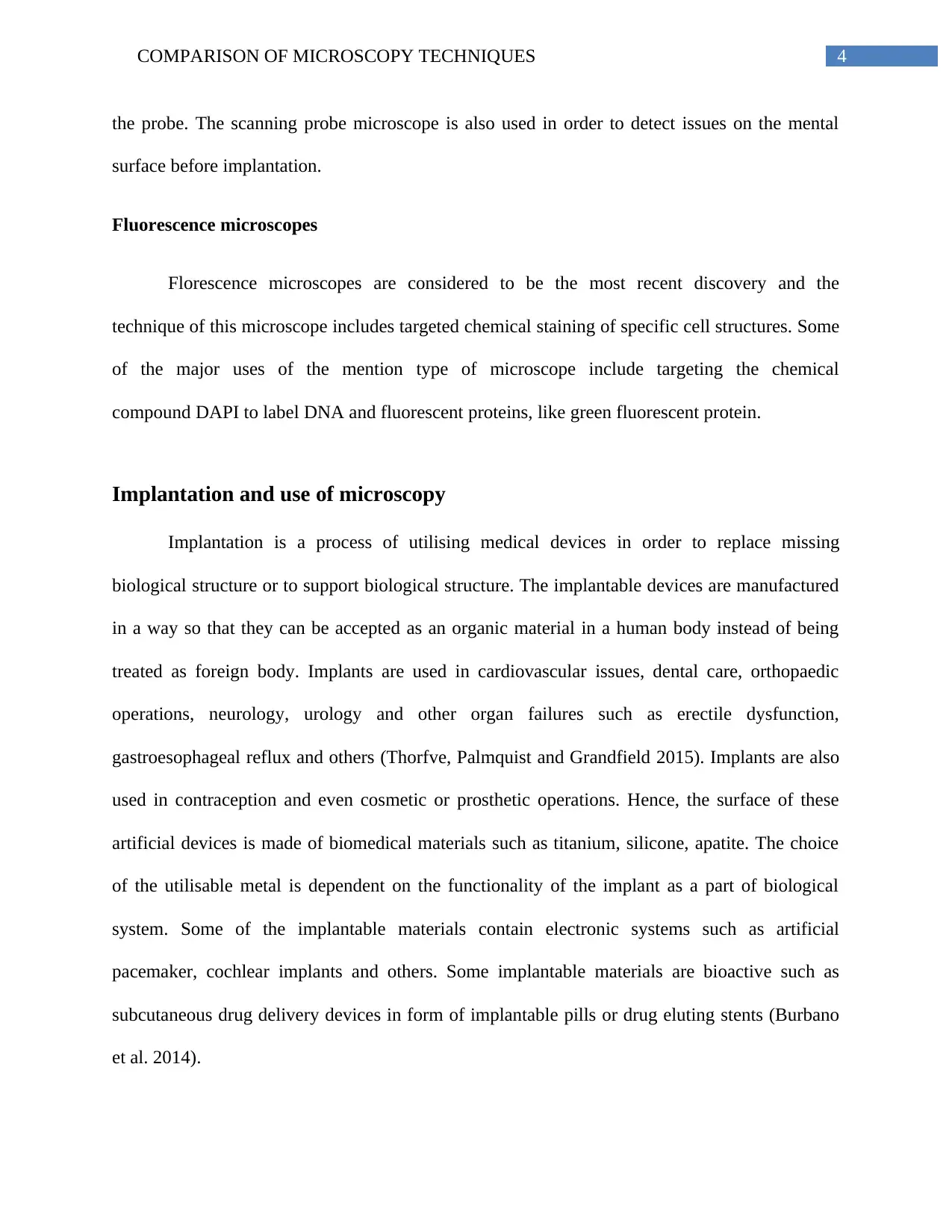
4COMPARISON OF MICROSCOPY TECHNIQUES
the probe. The scanning probe microscope is also used in order to detect issues on the mental
surface before implantation.
Fluorescence microscopes
Florescence microscopes are considered to be the most recent discovery and the
technique of this microscope includes targeted chemical staining of specific cell structures. Some
of the major uses of the mention type of microscope include targeting the chemical
compound DAPI to label DNA and fluorescent proteins, like green fluorescent protein.
Implantation and use of microscopy
Implantation is a process of utilising medical devices in order to replace missing
biological structure or to support biological structure. The implantable devices are manufactured
in a way so that they can be accepted as an organic material in a human body instead of being
treated as foreign body. Implants are used in cardiovascular issues, dental care, orthopaedic
operations, neurology, urology and other organ failures such as erectile dysfunction,
gastroesophageal reflux and others (Thorfve, Palmquist and Grandfield 2015). Implants are also
used in contraception and even cosmetic or prosthetic operations. Hence, the surface of these
artificial devices is made of biomedical materials such as titanium, silicone, apatite. The choice
of the utilisable metal is dependent on the functionality of the implant as a part of biological
system. Some of the implantable materials contain electronic systems such as artificial
pacemaker, cochlear implants and others. Some implantable materials are bioactive such as
subcutaneous drug delivery devices in form of implantable pills or drug eluting stents (Burbano
et al. 2014).
the probe. The scanning probe microscope is also used in order to detect issues on the mental
surface before implantation.
Fluorescence microscopes
Florescence microscopes are considered to be the most recent discovery and the
technique of this microscope includes targeted chemical staining of specific cell structures. Some
of the major uses of the mention type of microscope include targeting the chemical
compound DAPI to label DNA and fluorescent proteins, like green fluorescent protein.
Implantation and use of microscopy
Implantation is a process of utilising medical devices in order to replace missing
biological structure or to support biological structure. The implantable devices are manufactured
in a way so that they can be accepted as an organic material in a human body instead of being
treated as foreign body. Implants are used in cardiovascular issues, dental care, orthopaedic
operations, neurology, urology and other organ failures such as erectile dysfunction,
gastroesophageal reflux and others (Thorfve, Palmquist and Grandfield 2015). Implants are also
used in contraception and even cosmetic or prosthetic operations. Hence, the surface of these
artificial devices is made of biomedical materials such as titanium, silicone, apatite. The choice
of the utilisable metal is dependent on the functionality of the implant as a part of biological
system. Some of the implantable materials contain electronic systems such as artificial
pacemaker, cochlear implants and others. Some implantable materials are bioactive such as
subcutaneous drug delivery devices in form of implantable pills or drug eluting stents (Burbano
et al. 2014).
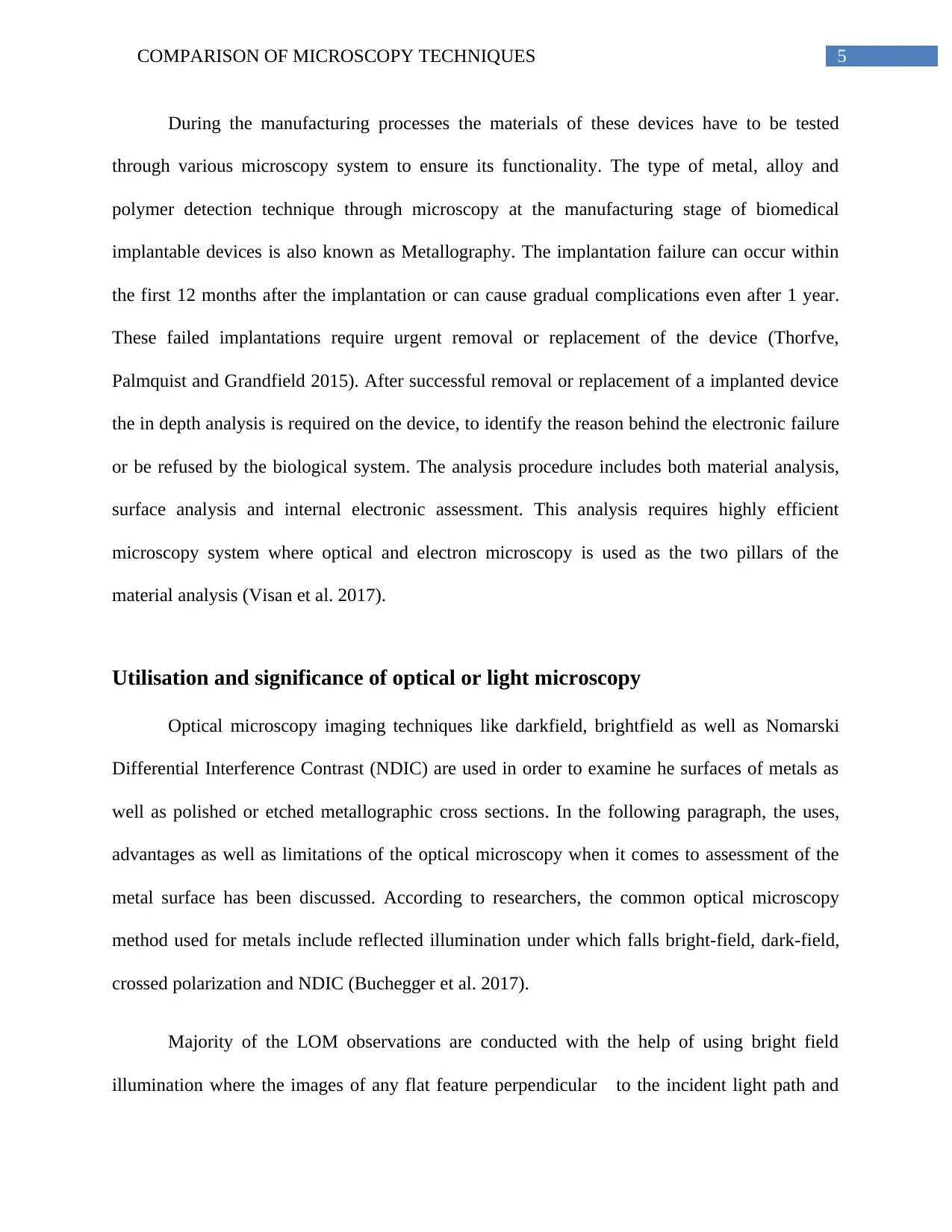
5COMPARISON OF MICROSCOPY TECHNIQUES
During the manufacturing processes the materials of these devices have to be tested
through various microscopy system to ensure its functionality. The type of metal, alloy and
polymer detection technique through microscopy at the manufacturing stage of biomedical
implantable devices is also known as Metallography. The implantation failure can occur within
the first 12 months after the implantation or can cause gradual complications even after 1 year.
These failed implantations require urgent removal or replacement of the device (Thorfve,
Palmquist and Grandfield 2015). After successful removal or replacement of a implanted device
the in depth analysis is required on the device, to identify the reason behind the electronic failure
or be refused by the biological system. The analysis procedure includes both material analysis,
surface analysis and internal electronic assessment. This analysis requires highly efficient
microscopy system where optical and electron microscopy is used as the two pillars of the
material analysis (Visan et al. 2017).
Utilisation and significance of optical or light microscopy
Optical microscopy imaging techniques like darkfield, brightfield as well as Nomarski
Differential Interference Contrast (NDIC) are used in order to examine he surfaces of metals as
well as polished or etched metallographic cross sections. In the following paragraph, the uses,
advantages as well as limitations of the optical microscopy when it comes to assessment of the
metal surface has been discussed. According to researchers, the common optical microscopy
method used for metals include reflected illumination under which falls bright-field, dark-field,
crossed polarization and NDIC (Buchegger et al. 2017).
Majority of the LOM observations are conducted with the help of using bright field
illumination where the images of any flat feature perpendicular to the incident light path and
During the manufacturing processes the materials of these devices have to be tested
through various microscopy system to ensure its functionality. The type of metal, alloy and
polymer detection technique through microscopy at the manufacturing stage of biomedical
implantable devices is also known as Metallography. The implantation failure can occur within
the first 12 months after the implantation or can cause gradual complications even after 1 year.
These failed implantations require urgent removal or replacement of the device (Thorfve,
Palmquist and Grandfield 2015). After successful removal or replacement of a implanted device
the in depth analysis is required on the device, to identify the reason behind the electronic failure
or be refused by the biological system. The analysis procedure includes both material analysis,
surface analysis and internal electronic assessment. This analysis requires highly efficient
microscopy system where optical and electron microscopy is used as the two pillars of the
material analysis (Visan et al. 2017).
Utilisation and significance of optical or light microscopy
Optical microscopy imaging techniques like darkfield, brightfield as well as Nomarski
Differential Interference Contrast (NDIC) are used in order to examine he surfaces of metals as
well as polished or etched metallographic cross sections. In the following paragraph, the uses,
advantages as well as limitations of the optical microscopy when it comes to assessment of the
metal surface has been discussed. According to researchers, the common optical microscopy
method used for metals include reflected illumination under which falls bright-field, dark-field,
crossed polarization and NDIC (Buchegger et al. 2017).
Majority of the LOM observations are conducted with the help of using bright field
illumination where the images of any flat feature perpendicular to the incident light path and
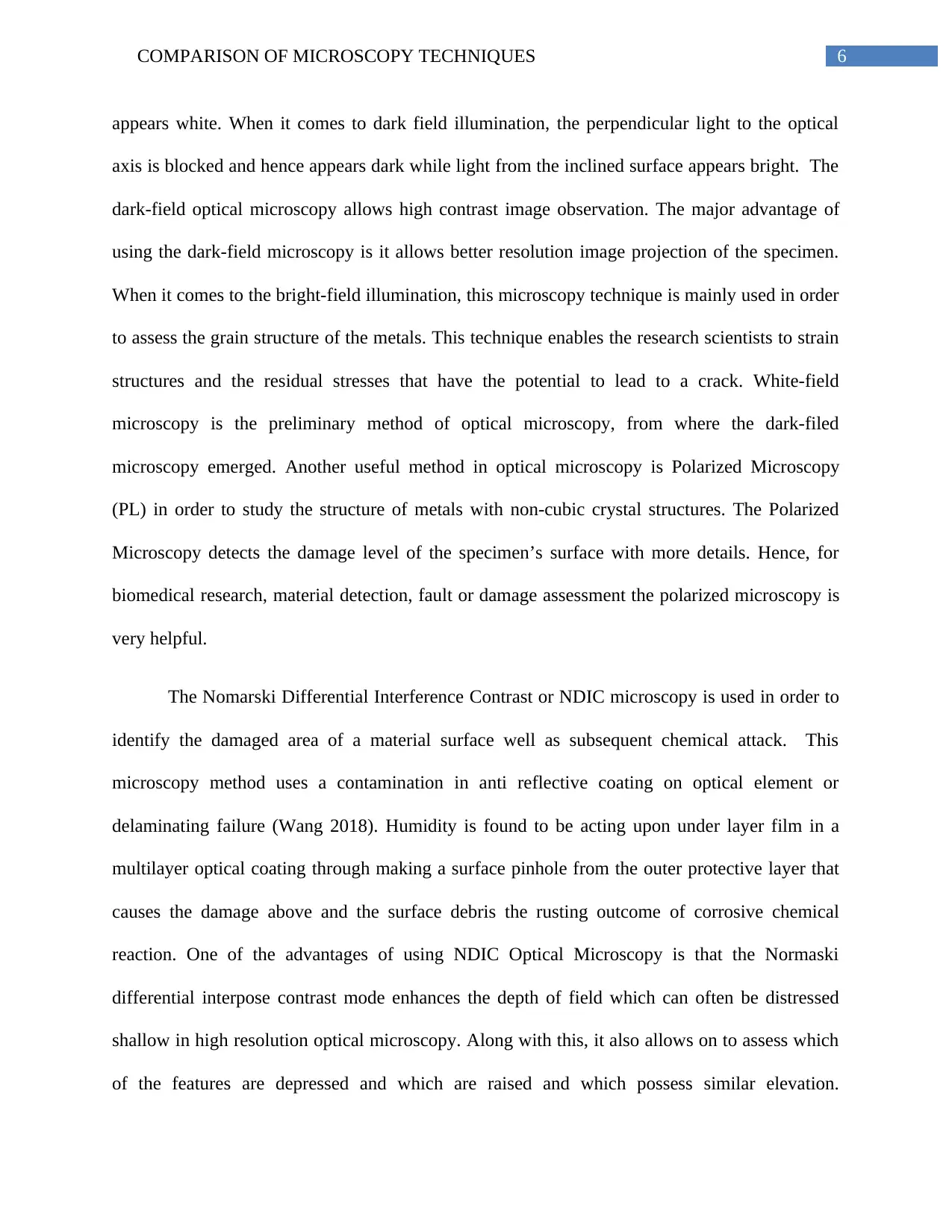
6COMPARISON OF MICROSCOPY TECHNIQUES
appears white. When it comes to dark field illumination, the perpendicular light to the optical
axis is blocked and hence appears dark while light from the inclined surface appears bright. The
dark-field optical microscopy allows high contrast image observation. The major advantage of
using the dark-field microscopy is it allows better resolution image projection of the specimen.
When it comes to the bright-field illumination, this microscopy technique is mainly used in order
to assess the grain structure of the metals. This technique enables the research scientists to strain
structures and the residual stresses that have the potential to lead to a crack. White-field
microscopy is the preliminary method of optical microscopy, from where the dark-filed
microscopy emerged. Another useful method in optical microscopy is Polarized Microscopy
(PL) in order to study the structure of metals with non-cubic crystal structures. The Polarized
Microscopy detects the damage level of the specimen’s surface with more details. Hence, for
biomedical research, material detection, fault or damage assessment the polarized microscopy is
very helpful.
The Nomarski Differential Interference Contrast or NDIC microscopy is used in order to
identify the damaged area of a material surface well as subsequent chemical attack. This
microscopy method uses a contamination in anti reflective coating on optical element or
delaminating failure (Wang 2018). Humidity is found to be acting upon under layer film in a
multilayer optical coating through making a surface pinhole from the outer protective layer that
causes the damage above and the surface debris the rusting outcome of corrosive chemical
reaction. One of the advantages of using NDIC Optical Microscopy is that the Normaski
differential interpose contrast mode enhances the depth of field which can often be distressed
shallow in high resolution optical microscopy. Along with this, it also allows on to assess which
of the features are depressed and which are raised and which possess similar elevation.
appears white. When it comes to dark field illumination, the perpendicular light to the optical
axis is blocked and hence appears dark while light from the inclined surface appears bright. The
dark-field optical microscopy allows high contrast image observation. The major advantage of
using the dark-field microscopy is it allows better resolution image projection of the specimen.
When it comes to the bright-field illumination, this microscopy technique is mainly used in order
to assess the grain structure of the metals. This technique enables the research scientists to strain
structures and the residual stresses that have the potential to lead to a crack. White-field
microscopy is the preliminary method of optical microscopy, from where the dark-filed
microscopy emerged. Another useful method in optical microscopy is Polarized Microscopy
(PL) in order to study the structure of metals with non-cubic crystal structures. The Polarized
Microscopy detects the damage level of the specimen’s surface with more details. Hence, for
biomedical research, material detection, fault or damage assessment the polarized microscopy is
very helpful.
The Nomarski Differential Interference Contrast or NDIC microscopy is used in order to
identify the damaged area of a material surface well as subsequent chemical attack. This
microscopy method uses a contamination in anti reflective coating on optical element or
delaminating failure (Wang 2018). Humidity is found to be acting upon under layer film in a
multilayer optical coating through making a surface pinhole from the outer protective layer that
causes the damage above and the surface debris the rusting outcome of corrosive chemical
reaction. One of the advantages of using NDIC Optical Microscopy is that the Normaski
differential interpose contrast mode enhances the depth of field which can often be distressed
shallow in high resolution optical microscopy. Along with this, it also allows on to assess which
of the features are depressed and which are raised and which possess similar elevation.
Paraphrase This Document
Need a fresh take? Get an instant paraphrase of this document with our AI Paraphraser
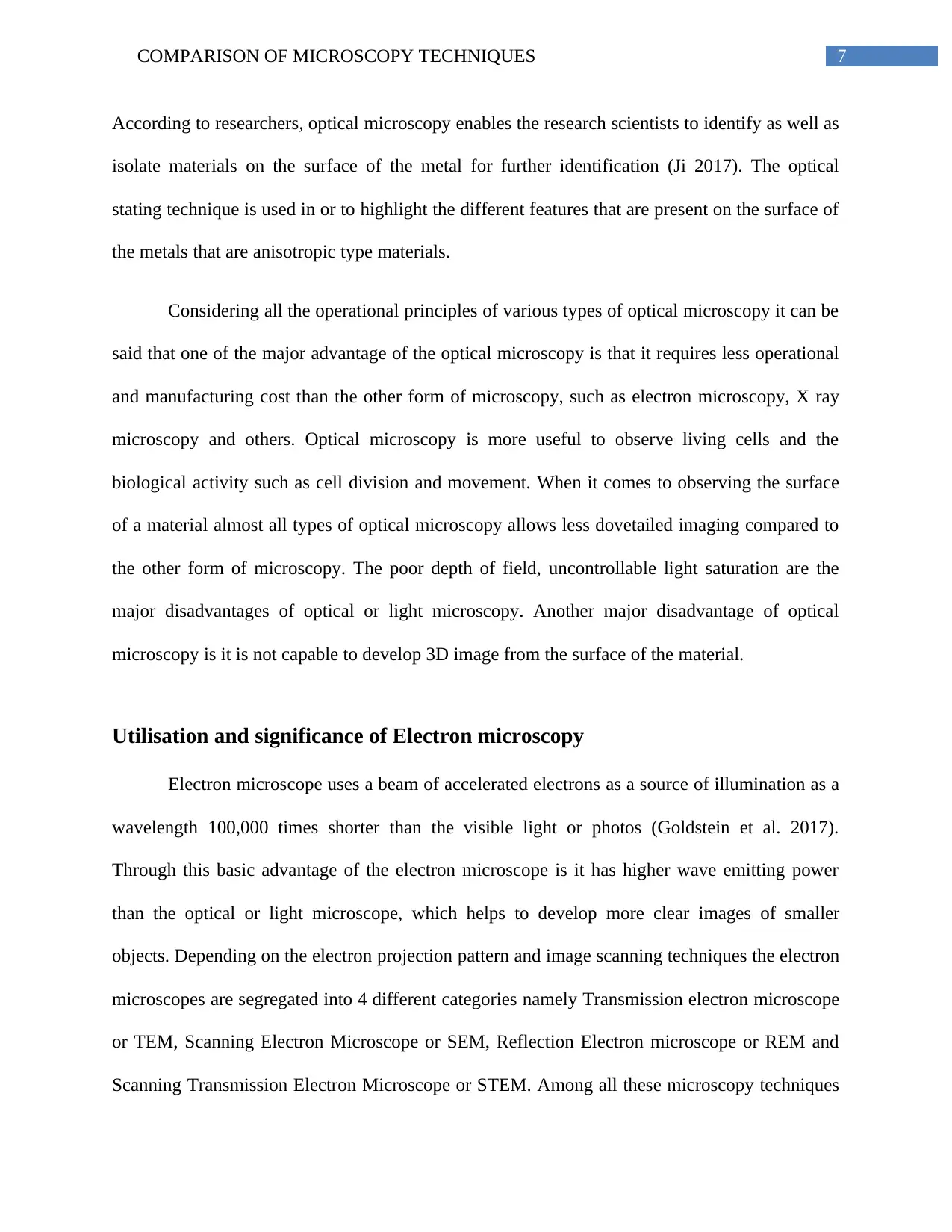
7COMPARISON OF MICROSCOPY TECHNIQUES
According to researchers, optical microscopy enables the research scientists to identify as well as
isolate materials on the surface of the metal for further identification (Ji 2017). The optical
stating technique is used in or to highlight the different features that are present on the surface of
the metals that are anisotropic type materials.
Considering all the operational principles of various types of optical microscopy it can be
said that one of the major advantage of the optical microscopy is that it requires less operational
and manufacturing cost than the other form of microscopy, such as electron microscopy, X ray
microscopy and others. Optical microscopy is more useful to observe living cells and the
biological activity such as cell division and movement. When it comes to observing the surface
of a material almost all types of optical microscopy allows less dovetailed imaging compared to
the other form of microscopy. The poor depth of field, uncontrollable light saturation are the
major disadvantages of optical or light microscopy. Another major disadvantage of optical
microscopy is it is not capable to develop 3D image from the surface of the material.
Utilisation and significance of Electron microscopy
Electron microscope uses a beam of accelerated electrons as a source of illumination as a
wavelength 100,000 times shorter than the visible light or photos (Goldstein et al. 2017).
Through this basic advantage of the electron microscope is it has higher wave emitting power
than the optical or light microscope, which helps to develop more clear images of smaller
objects. Depending on the electron projection pattern and image scanning techniques the electron
microscopes are segregated into 4 different categories namely Transmission electron microscope
or TEM, Scanning Electron Microscope or SEM, Reflection Electron microscope or REM and
Scanning Transmission Electron Microscope or STEM. Among all these microscopy techniques
According to researchers, optical microscopy enables the research scientists to identify as well as
isolate materials on the surface of the metal for further identification (Ji 2017). The optical
stating technique is used in or to highlight the different features that are present on the surface of
the metals that are anisotropic type materials.
Considering all the operational principles of various types of optical microscopy it can be
said that one of the major advantage of the optical microscopy is that it requires less operational
and manufacturing cost than the other form of microscopy, such as electron microscopy, X ray
microscopy and others. Optical microscopy is more useful to observe living cells and the
biological activity such as cell division and movement. When it comes to observing the surface
of a material almost all types of optical microscopy allows less dovetailed imaging compared to
the other form of microscopy. The poor depth of field, uncontrollable light saturation are the
major disadvantages of optical or light microscopy. Another major disadvantage of optical
microscopy is it is not capable to develop 3D image from the surface of the material.
Utilisation and significance of Electron microscopy
Electron microscope uses a beam of accelerated electrons as a source of illumination as a
wavelength 100,000 times shorter than the visible light or photos (Goldstein et al. 2017).
Through this basic advantage of the electron microscope is it has higher wave emitting power
than the optical or light microscope, which helps to develop more clear images of smaller
objects. Depending on the electron projection pattern and image scanning techniques the electron
microscopes are segregated into 4 different categories namely Transmission electron microscope
or TEM, Scanning Electron Microscope or SEM, Reflection Electron microscope or REM and
Scanning Transmission Electron Microscope or STEM. Among all these microscopy techniques
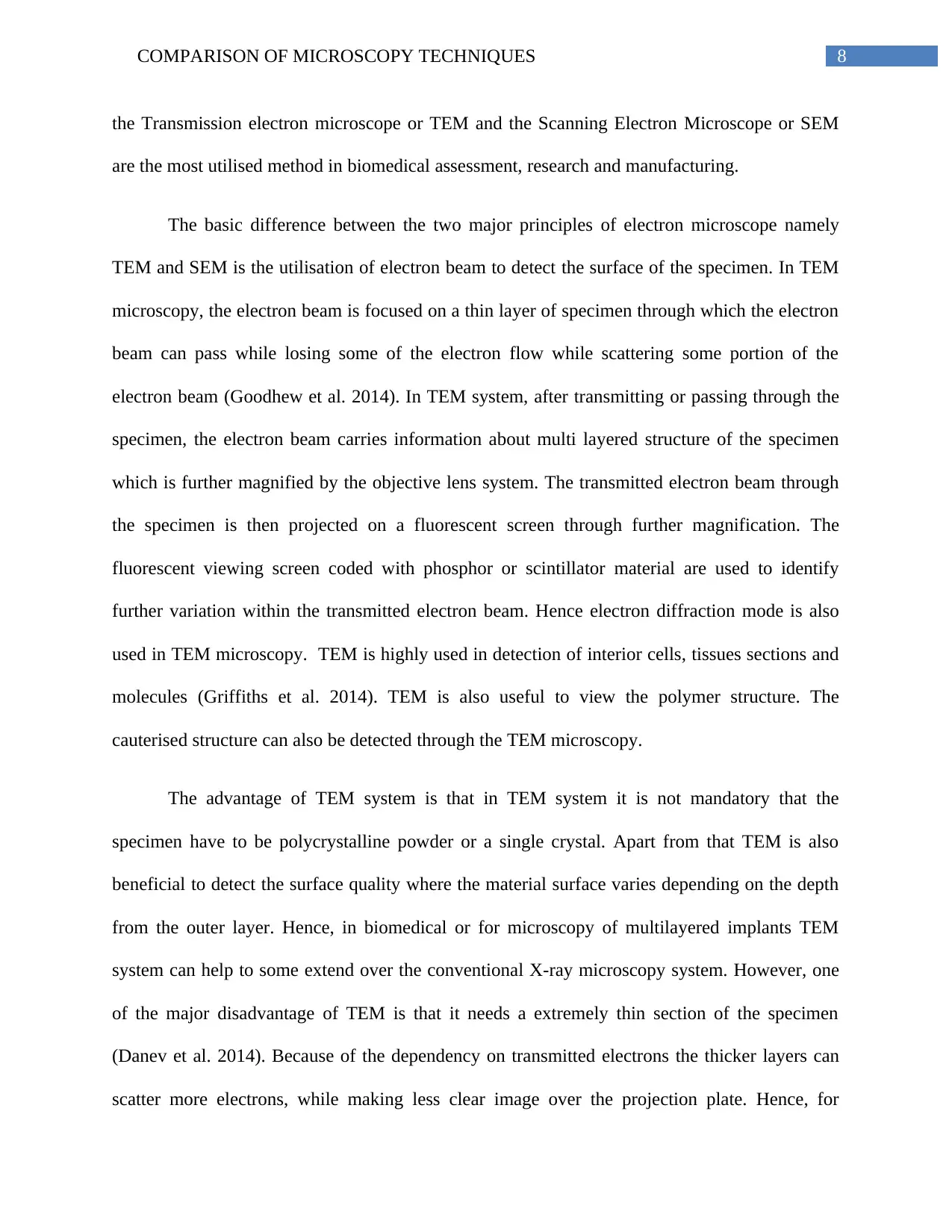
8COMPARISON OF MICROSCOPY TECHNIQUES
the Transmission electron microscope or TEM and the Scanning Electron Microscope or SEM
are the most utilised method in biomedical assessment, research and manufacturing.
The basic difference between the two major principles of electron microscope namely
TEM and SEM is the utilisation of electron beam to detect the surface of the specimen. In TEM
microscopy, the electron beam is focused on a thin layer of specimen through which the electron
beam can pass while losing some of the electron flow while scattering some portion of the
electron beam (Goodhew et al. 2014). In TEM system, after transmitting or passing through the
specimen, the electron beam carries information about multi layered structure of the specimen
which is further magnified by the objective lens system. The transmitted electron beam through
the specimen is then projected on a fluorescent screen through further magnification. The
fluorescent viewing screen coded with phosphor or scintillator material are used to identify
further variation within the transmitted electron beam. Hence electron diffraction mode is also
used in TEM microscopy. TEM is highly used in detection of interior cells, tissues sections and
molecules (Griffiths et al. 2014). TEM is also useful to view the polymer structure. The
cauterised structure can also be detected through the TEM microscopy.
The advantage of TEM system is that in TEM system it is not mandatory that the
specimen have to be polycrystalline powder or a single crystal. Apart from that TEM is also
beneficial to detect the surface quality where the material surface varies depending on the depth
from the outer layer. Hence, in biomedical or for microscopy of multilayered implants TEM
system can help to some extend over the conventional X-ray microscopy system. However, one
of the major disadvantage of TEM is that it needs a extremely thin section of the specimen
(Danev et al. 2014). Because of the dependency on transmitted electrons the thicker layers can
scatter more electrons, while making less clear image over the projection plate. Hence, for
the Transmission electron microscope or TEM and the Scanning Electron Microscope or SEM
are the most utilised method in biomedical assessment, research and manufacturing.
The basic difference between the two major principles of electron microscope namely
TEM and SEM is the utilisation of electron beam to detect the surface of the specimen. In TEM
microscopy, the electron beam is focused on a thin layer of specimen through which the electron
beam can pass while losing some of the electron flow while scattering some portion of the
electron beam (Goodhew et al. 2014). In TEM system, after transmitting or passing through the
specimen, the electron beam carries information about multi layered structure of the specimen
which is further magnified by the objective lens system. The transmitted electron beam through
the specimen is then projected on a fluorescent screen through further magnification. The
fluorescent viewing screen coded with phosphor or scintillator material are used to identify
further variation within the transmitted electron beam. Hence electron diffraction mode is also
used in TEM microscopy. TEM is highly used in detection of interior cells, tissues sections and
molecules (Griffiths et al. 2014). TEM is also useful to view the polymer structure. The
cauterised structure can also be detected through the TEM microscopy.
The advantage of TEM system is that in TEM system it is not mandatory that the
specimen have to be polycrystalline powder or a single crystal. Apart from that TEM is also
beneficial to detect the surface quality where the material surface varies depending on the depth
from the outer layer. Hence, in biomedical or for microscopy of multilayered implants TEM
system can help to some extend over the conventional X-ray microscopy system. However, one
of the major disadvantage of TEM is that it needs a extremely thin section of the specimen
(Danev et al. 2014). Because of the dependency on transmitted electrons the thicker layers can
scatter more electrons, while making less clear image over the projection plate. Hence, for
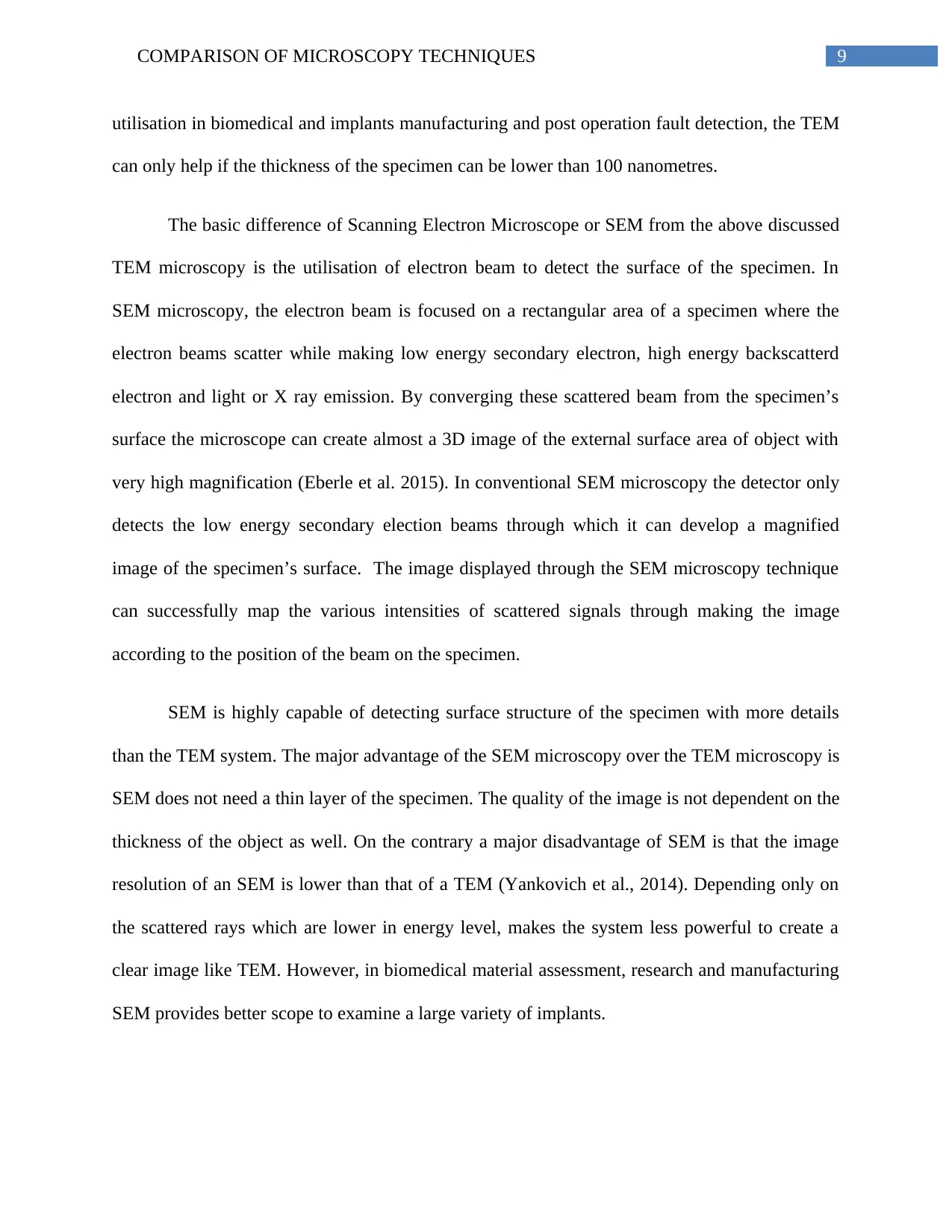
9COMPARISON OF MICROSCOPY TECHNIQUES
utilisation in biomedical and implants manufacturing and post operation fault detection, the TEM
can only help if the thickness of the specimen can be lower than 100 nanometres.
The basic difference of Scanning Electron Microscope or SEM from the above discussed
TEM microscopy is the utilisation of electron beam to detect the surface of the specimen. In
SEM microscopy, the electron beam is focused on a rectangular area of a specimen where the
electron beams scatter while making low energy secondary electron, high energy backscatterd
electron and light or X ray emission. By converging these scattered beam from the specimen’s
surface the microscope can create almost a 3D image of the external surface area of object with
very high magnification (Eberle et al. 2015). In conventional SEM microscopy the detector only
detects the low energy secondary election beams through which it can develop a magnified
image of the specimen’s surface. The image displayed through the SEM microscopy technique
can successfully map the various intensities of scattered signals through making the image
according to the position of the beam on the specimen.
SEM is highly capable of detecting surface structure of the specimen with more details
than the TEM system. The major advantage of the SEM microscopy over the TEM microscopy is
SEM does not need a thin layer of the specimen. The quality of the image is not dependent on the
thickness of the object as well. On the contrary a major disadvantage of SEM is that the image
resolution of an SEM is lower than that of a TEM (Yankovich et al., 2014). Depending only on
the scattered rays which are lower in energy level, makes the system less powerful to create a
clear image like TEM. However, in biomedical material assessment, research and manufacturing
SEM provides better scope to examine a large variety of implants.
utilisation in biomedical and implants manufacturing and post operation fault detection, the TEM
can only help if the thickness of the specimen can be lower than 100 nanometres.
The basic difference of Scanning Electron Microscope or SEM from the above discussed
TEM microscopy is the utilisation of electron beam to detect the surface of the specimen. In
SEM microscopy, the electron beam is focused on a rectangular area of a specimen where the
electron beams scatter while making low energy secondary electron, high energy backscatterd
electron and light or X ray emission. By converging these scattered beam from the specimen’s
surface the microscope can create almost a 3D image of the external surface area of object with
very high magnification (Eberle et al. 2015). In conventional SEM microscopy the detector only
detects the low energy secondary election beams through which it can develop a magnified
image of the specimen’s surface. The image displayed through the SEM microscopy technique
can successfully map the various intensities of scattered signals through making the image
according to the position of the beam on the specimen.
SEM is highly capable of detecting surface structure of the specimen with more details
than the TEM system. The major advantage of the SEM microscopy over the TEM microscopy is
SEM does not need a thin layer of the specimen. The quality of the image is not dependent on the
thickness of the object as well. On the contrary a major disadvantage of SEM is that the image
resolution of an SEM is lower than that of a TEM (Yankovich et al., 2014). Depending only on
the scattered rays which are lower in energy level, makes the system less powerful to create a
clear image like TEM. However, in biomedical material assessment, research and manufacturing
SEM provides better scope to examine a large variety of implants.
Secure Best Marks with AI Grader
Need help grading? Try our AI Grader for instant feedback on your assignments.
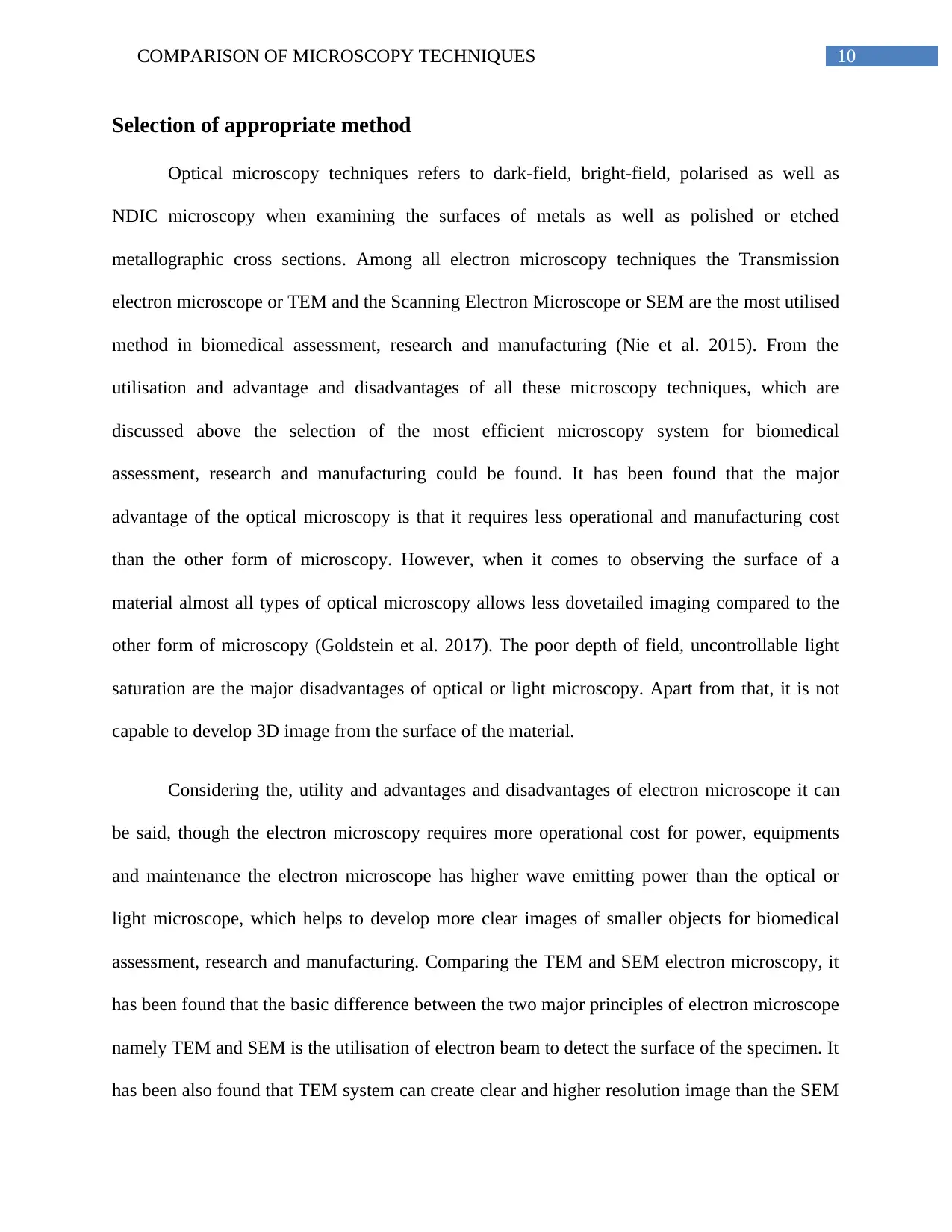
10COMPARISON OF MICROSCOPY TECHNIQUES
Selection of appropriate method
Optical microscopy techniques refers to dark-field, bright-field, polarised as well as
NDIC microscopy when examining the surfaces of metals as well as polished or etched
metallographic cross sections. Among all electron microscopy techniques the Transmission
electron microscope or TEM and the Scanning Electron Microscope or SEM are the most utilised
method in biomedical assessment, research and manufacturing (Nie et al. 2015). From the
utilisation and advantage and disadvantages of all these microscopy techniques, which are
discussed above the selection of the most efficient microscopy system for biomedical
assessment, research and manufacturing could be found. It has been found that the major
advantage of the optical microscopy is that it requires less operational and manufacturing cost
than the other form of microscopy. However, when it comes to observing the surface of a
material almost all types of optical microscopy allows less dovetailed imaging compared to the
other form of microscopy (Goldstein et al. 2017). The poor depth of field, uncontrollable light
saturation are the major disadvantages of optical or light microscopy. Apart from that, it is not
capable to develop 3D image from the surface of the material.
Considering the, utility and advantages and disadvantages of electron microscope it can
be said, though the electron microscopy requires more operational cost for power, equipments
and maintenance the electron microscope has higher wave emitting power than the optical or
light microscope, which helps to develop more clear images of smaller objects for biomedical
assessment, research and manufacturing. Comparing the TEM and SEM electron microscopy, it
has been found that the basic difference between the two major principles of electron microscope
namely TEM and SEM is the utilisation of electron beam to detect the surface of the specimen. It
has been also found that TEM system can create clear and higher resolution image than the SEM
Selection of appropriate method
Optical microscopy techniques refers to dark-field, bright-field, polarised as well as
NDIC microscopy when examining the surfaces of metals as well as polished or etched
metallographic cross sections. Among all electron microscopy techniques the Transmission
electron microscope or TEM and the Scanning Electron Microscope or SEM are the most utilised
method in biomedical assessment, research and manufacturing (Nie et al. 2015). From the
utilisation and advantage and disadvantages of all these microscopy techniques, which are
discussed above the selection of the most efficient microscopy system for biomedical
assessment, research and manufacturing could be found. It has been found that the major
advantage of the optical microscopy is that it requires less operational and manufacturing cost
than the other form of microscopy. However, when it comes to observing the surface of a
material almost all types of optical microscopy allows less dovetailed imaging compared to the
other form of microscopy (Goldstein et al. 2017). The poor depth of field, uncontrollable light
saturation are the major disadvantages of optical or light microscopy. Apart from that, it is not
capable to develop 3D image from the surface of the material.
Considering the, utility and advantages and disadvantages of electron microscope it can
be said, though the electron microscopy requires more operational cost for power, equipments
and maintenance the electron microscope has higher wave emitting power than the optical or
light microscope, which helps to develop more clear images of smaller objects for biomedical
assessment, research and manufacturing. Comparing the TEM and SEM electron microscopy, it
has been found that the basic difference between the two major principles of electron microscope
namely TEM and SEM is the utilisation of electron beam to detect the surface of the specimen. It
has been also found that TEM system can create clear and higher resolution image than the SEM
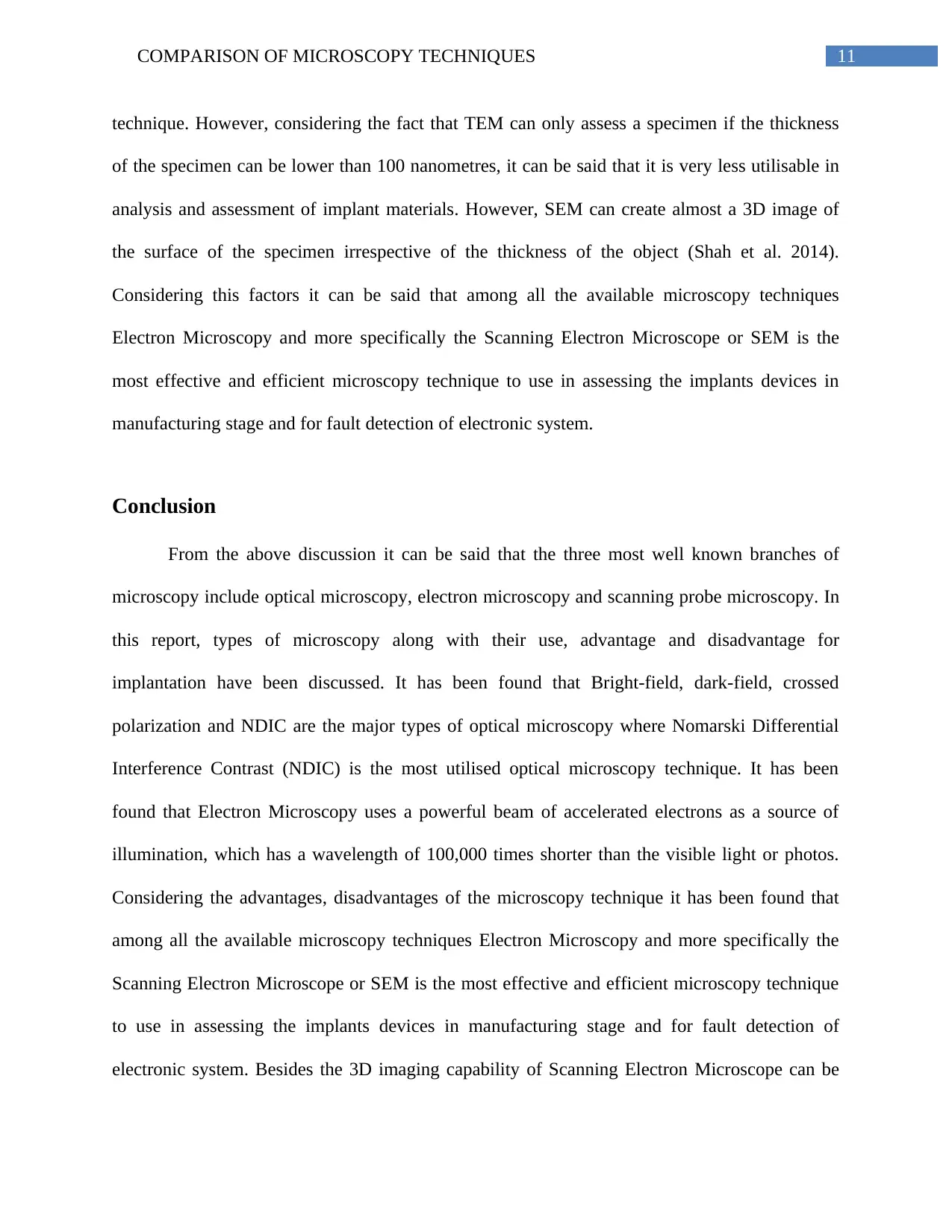
11COMPARISON OF MICROSCOPY TECHNIQUES
technique. However, considering the fact that TEM can only assess a specimen if the thickness
of the specimen can be lower than 100 nanometres, it can be said that it is very less utilisable in
analysis and assessment of implant materials. However, SEM can create almost a 3D image of
the surface of the specimen irrespective of the thickness of the object (Shah et al. 2014).
Considering this factors it can be said that among all the available microscopy techniques
Electron Microscopy and more specifically the Scanning Electron Microscope or SEM is the
most effective and efficient microscopy technique to use in assessing the implants devices in
manufacturing stage and for fault detection of electronic system.
Conclusion
From the above discussion it can be said that the three most well known branches of
microscopy include optical microscopy, electron microscopy and scanning probe microscopy. In
this report, types of microscopy along with their use, advantage and disadvantage for
implantation have been discussed. It has been found that Bright-field, dark-field, crossed
polarization and NDIC are the major types of optical microscopy where Nomarski Differential
Interference Contrast (NDIC) is the most utilised optical microscopy technique. It has been
found that Electron Microscopy uses a powerful beam of accelerated electrons as a source of
illumination, which has a wavelength of 100,000 times shorter than the visible light or photos.
Considering the advantages, disadvantages of the microscopy technique it has been found that
among all the available microscopy techniques Electron Microscopy and more specifically the
Scanning Electron Microscope or SEM is the most effective and efficient microscopy technique
to use in assessing the implants devices in manufacturing stage and for fault detection of
electronic system. Besides the 3D imaging capability of Scanning Electron Microscope can be
technique. However, considering the fact that TEM can only assess a specimen if the thickness
of the specimen can be lower than 100 nanometres, it can be said that it is very less utilisable in
analysis and assessment of implant materials. However, SEM can create almost a 3D image of
the surface of the specimen irrespective of the thickness of the object (Shah et al. 2014).
Considering this factors it can be said that among all the available microscopy techniques
Electron Microscopy and more specifically the Scanning Electron Microscope or SEM is the
most effective and efficient microscopy technique to use in assessing the implants devices in
manufacturing stage and for fault detection of electronic system.
Conclusion
From the above discussion it can be said that the three most well known branches of
microscopy include optical microscopy, electron microscopy and scanning probe microscopy. In
this report, types of microscopy along with their use, advantage and disadvantage for
implantation have been discussed. It has been found that Bright-field, dark-field, crossed
polarization and NDIC are the major types of optical microscopy where Nomarski Differential
Interference Contrast (NDIC) is the most utilised optical microscopy technique. It has been
found that Electron Microscopy uses a powerful beam of accelerated electrons as a source of
illumination, which has a wavelength of 100,000 times shorter than the visible light or photos.
Considering the advantages, disadvantages of the microscopy technique it has been found that
among all the available microscopy techniques Electron Microscopy and more specifically the
Scanning Electron Microscope or SEM is the most effective and efficient microscopy technique
to use in assessing the implants devices in manufacturing stage and for fault detection of
electronic system. Besides the 3D imaging capability of Scanning Electron Microscope can be

12COMPARISON OF MICROSCOPY TECHNIQUES
utilised for electronic implants to assess the quality of the implants and to find the cause of the
fault.
utilised for electronic implants to assess the quality of the implants and to find the cause of the
fault.
Paraphrase This Document
Need a fresh take? Get an instant paraphrase of this document with our AI Paraphraser
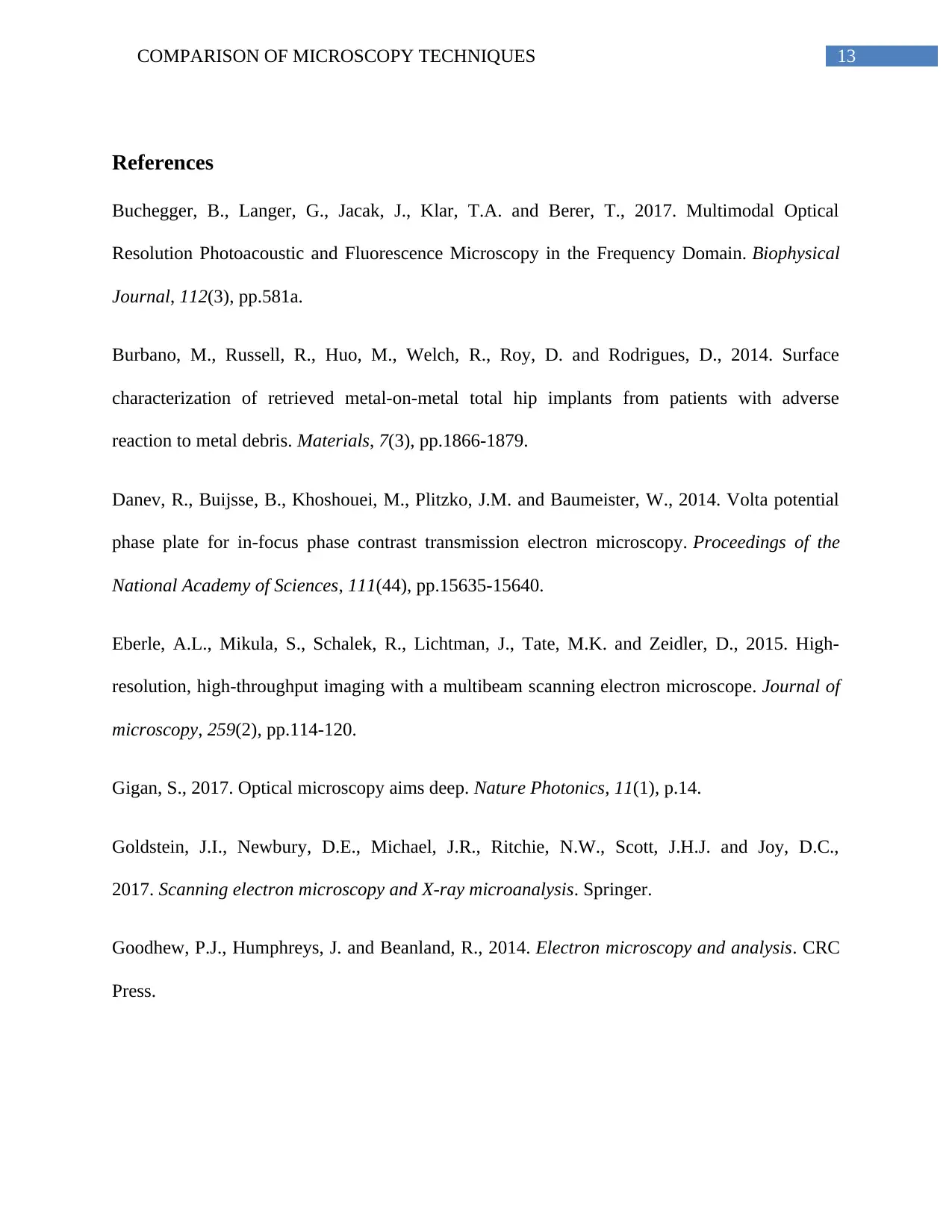
13COMPARISON OF MICROSCOPY TECHNIQUES
References
Buchegger, B., Langer, G., Jacak, J., Klar, T.A. and Berer, T., 2017. Multimodal Optical
Resolution Photoacoustic and Fluorescence Microscopy in the Frequency Domain. Biophysical
Journal, 112(3), pp.581a.
Burbano, M., Russell, R., Huo, M., Welch, R., Roy, D. and Rodrigues, D., 2014. Surface
characterization of retrieved metal-on-metal total hip implants from patients with adverse
reaction to metal debris. Materials, 7(3), pp.1866-1879.
Danev, R., Buijsse, B., Khoshouei, M., Plitzko, J.M. and Baumeister, W., 2014. Volta potential
phase plate for in-focus phase contrast transmission electron microscopy. Proceedings of the
National Academy of Sciences, 111(44), pp.15635-15640.
Eberle, A.L., Mikula, S., Schalek, R., Lichtman, J., Tate, M.K. and Zeidler, D., 2015. High‐
resolution, high‐throughput imaging with a multibeam scanning electron microscope. Journal of
microscopy, 259(2), pp.114-120.
Gigan, S., 2017. Optical microscopy aims deep. Nature Photonics, 11(1), p.14.
Goldstein, J.I., Newbury, D.E., Michael, J.R., Ritchie, N.W., Scott, J.H.J. and Joy, D.C.,
2017. Scanning electron microscopy and X-ray microanalysis. Springer.
Goodhew, P.J., Humphreys, J. and Beanland, R., 2014. Electron microscopy and analysis. CRC
Press.
References
Buchegger, B., Langer, G., Jacak, J., Klar, T.A. and Berer, T., 2017. Multimodal Optical
Resolution Photoacoustic and Fluorescence Microscopy in the Frequency Domain. Biophysical
Journal, 112(3), pp.581a.
Burbano, M., Russell, R., Huo, M., Welch, R., Roy, D. and Rodrigues, D., 2014. Surface
characterization of retrieved metal-on-metal total hip implants from patients with adverse
reaction to metal debris. Materials, 7(3), pp.1866-1879.
Danev, R., Buijsse, B., Khoshouei, M., Plitzko, J.M. and Baumeister, W., 2014. Volta potential
phase plate for in-focus phase contrast transmission electron microscopy. Proceedings of the
National Academy of Sciences, 111(44), pp.15635-15640.
Eberle, A.L., Mikula, S., Schalek, R., Lichtman, J., Tate, M.K. and Zeidler, D., 2015. High‐
resolution, high‐throughput imaging with a multibeam scanning electron microscope. Journal of
microscopy, 259(2), pp.114-120.
Gigan, S., 2017. Optical microscopy aims deep. Nature Photonics, 11(1), p.14.
Goldstein, J.I., Newbury, D.E., Michael, J.R., Ritchie, N.W., Scott, J.H.J. and Joy, D.C.,
2017. Scanning electron microscopy and X-ray microanalysis. Springer.
Goodhew, P.J., Humphreys, J. and Beanland, R., 2014. Electron microscopy and analysis. CRC
Press.
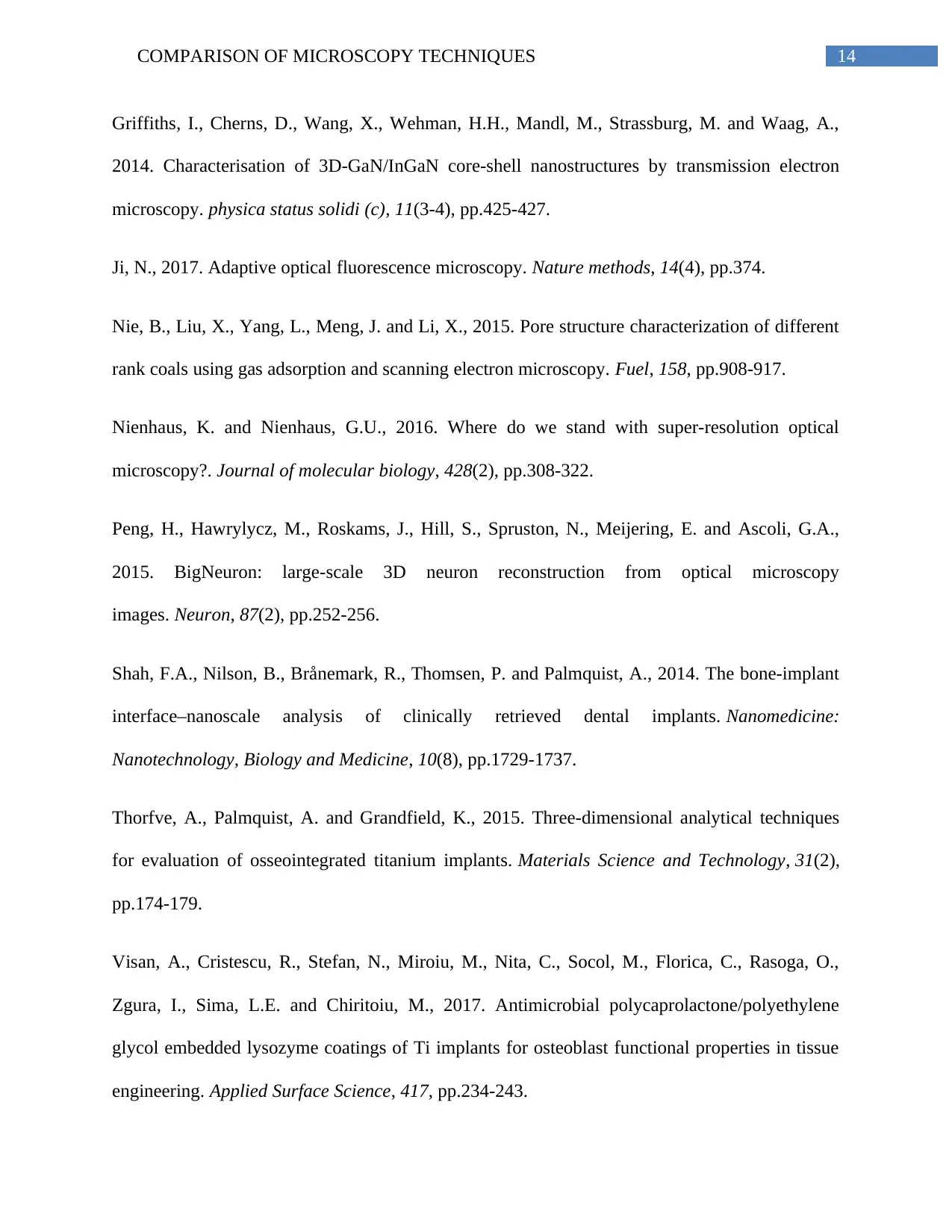
14COMPARISON OF MICROSCOPY TECHNIQUES
Griffiths, I., Cherns, D., Wang, X., Wehman, H.H., Mandl, M., Strassburg, M. and Waag, A.,
2014. Characterisation of 3D‐GaN/InGaN core‐shell nanostructures by transmission electron
microscopy. physica status solidi (c), 11(3‐4), pp.425-427.
Ji, N., 2017. Adaptive optical fluorescence microscopy. Nature methods, 14(4), pp.374.
Nie, B., Liu, X., Yang, L., Meng, J. and Li, X., 2015. Pore structure characterization of different
rank coals using gas adsorption and scanning electron microscopy. Fuel, 158, pp.908-917.
Nienhaus, K. and Nienhaus, G.U., 2016. Where do we stand with super-resolution optical
microscopy?. Journal of molecular biology, 428(2), pp.308-322.
Peng, H., Hawrylycz, M., Roskams, J., Hill, S., Spruston, N., Meijering, E. and Ascoli, G.A.,
2015. BigNeuron: large-scale 3D neuron reconstruction from optical microscopy
images. Neuron, 87(2), pp.252-256.
Shah, F.A., Nilson, B., Brånemark, R., Thomsen, P. and Palmquist, A., 2014. The bone-implant
interface–nanoscale analysis of clinically retrieved dental implants. Nanomedicine:
Nanotechnology, Biology and Medicine, 10(8), pp.1729-1737.
Thorfve, A., Palmquist, A. and Grandfield, K., 2015. Three-dimensional analytical techniques
for evaluation of osseointegrated titanium implants. Materials Science and Technology, 31(2),
pp.174-179.
Visan, A., Cristescu, R., Stefan, N., Miroiu, M., Nita, C., Socol, M., Florica, C., Rasoga, O.,
Zgura, I., Sima, L.E. and Chiritoiu, M., 2017. Antimicrobial polycaprolactone/polyethylene
glycol embedded lysozyme coatings of Ti implants for osteoblast functional properties in tissue
engineering. Applied Surface Science, 417, pp.234-243.
Griffiths, I., Cherns, D., Wang, X., Wehman, H.H., Mandl, M., Strassburg, M. and Waag, A.,
2014. Characterisation of 3D‐GaN/InGaN core‐shell nanostructures by transmission electron
microscopy. physica status solidi (c), 11(3‐4), pp.425-427.
Ji, N., 2017. Adaptive optical fluorescence microscopy. Nature methods, 14(4), pp.374.
Nie, B., Liu, X., Yang, L., Meng, J. and Li, X., 2015. Pore structure characterization of different
rank coals using gas adsorption and scanning electron microscopy. Fuel, 158, pp.908-917.
Nienhaus, K. and Nienhaus, G.U., 2016. Where do we stand with super-resolution optical
microscopy?. Journal of molecular biology, 428(2), pp.308-322.
Peng, H., Hawrylycz, M., Roskams, J., Hill, S., Spruston, N., Meijering, E. and Ascoli, G.A.,
2015. BigNeuron: large-scale 3D neuron reconstruction from optical microscopy
images. Neuron, 87(2), pp.252-256.
Shah, F.A., Nilson, B., Brånemark, R., Thomsen, P. and Palmquist, A., 2014. The bone-implant
interface–nanoscale analysis of clinically retrieved dental implants. Nanomedicine:
Nanotechnology, Biology and Medicine, 10(8), pp.1729-1737.
Thorfve, A., Palmquist, A. and Grandfield, K., 2015. Three-dimensional analytical techniques
for evaluation of osseointegrated titanium implants. Materials Science and Technology, 31(2),
pp.174-179.
Visan, A., Cristescu, R., Stefan, N., Miroiu, M., Nita, C., Socol, M., Florica, C., Rasoga, O.,
Zgura, I., Sima, L.E. and Chiritoiu, M., 2017. Antimicrobial polycaprolactone/polyethylene
glycol embedded lysozyme coatings of Ti implants for osteoblast functional properties in tissue
engineering. Applied Surface Science, 417, pp.234-243.
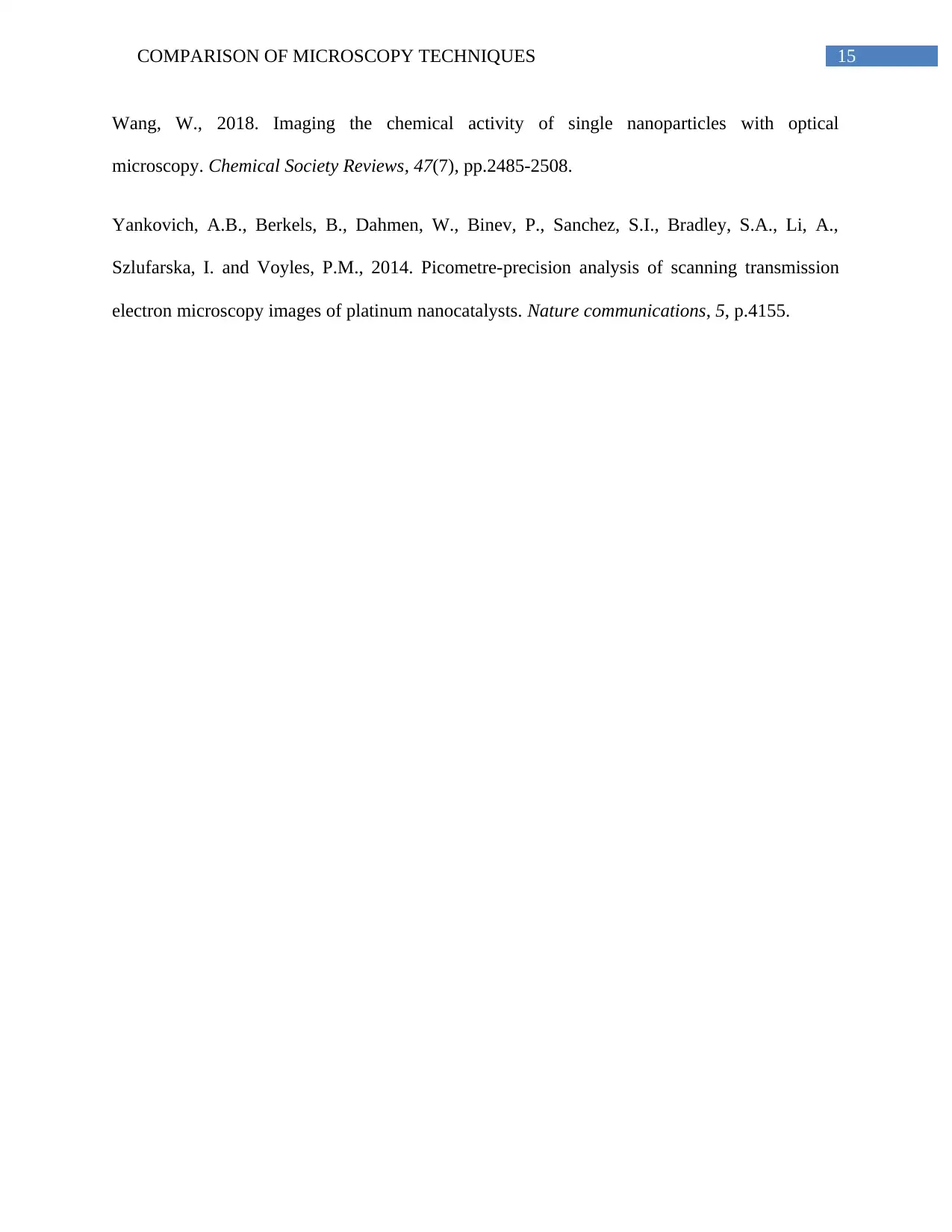
15COMPARISON OF MICROSCOPY TECHNIQUES
Wang, W., 2018. Imaging the chemical activity of single nanoparticles with optical
microscopy. Chemical Society Reviews, 47(7), pp.2485-2508.
Yankovich, A.B., Berkels, B., Dahmen, W., Binev, P., Sanchez, S.I., Bradley, S.A., Li, A.,
Szlufarska, I. and Voyles, P.M., 2014. Picometre-precision analysis of scanning transmission
electron microscopy images of platinum nanocatalysts. Nature communications, 5, p.4155.
Wang, W., 2018. Imaging the chemical activity of single nanoparticles with optical
microscopy. Chemical Society Reviews, 47(7), pp.2485-2508.
Yankovich, A.B., Berkels, B., Dahmen, W., Binev, P., Sanchez, S.I., Bradley, S.A., Li, A.,
Szlufarska, I. and Voyles, P.M., 2014. Picometre-precision analysis of scanning transmission
electron microscopy images of platinum nanocatalysts. Nature communications, 5, p.4155.
1 out of 16
Related Documents
Your All-in-One AI-Powered Toolkit for Academic Success.
+13062052269
info@desklib.com
Available 24*7 on WhatsApp / Email
![[object Object]](/_next/static/media/star-bottom.7253800d.svg)
Unlock your academic potential
© 2024 | Zucol Services PVT LTD | All rights reserved.





